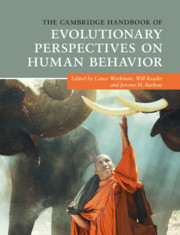Book contents
- The Cambridge Handbook of Evolutionary Perspectives on Human Behavior
- The Cambridge Handbook of Evolutionary Perspectives on Human Behavior
- Copyright page
- Dedication
- Contents
- Figures
- Tables
- Contributors
- Preface
- Acknowledgments
- Part I The Comparative Approach
- Part II Sociocultural Anthropology and Evolution
- Part III Evolution and Neuroscience
- Part IV Group Living
- Part V Evolution and Cognition
- Part VI Evolution and Development
- Part VII Sexual Selection and Human Sex Differences
- 26 Survival, Selection, and Sex Differences in Fear
- 27 The Enigmatic Urge
- 28 Are Humans Peacocks or Robins?
- 29 Human Mate Selection
- 30 Kin Selection and the Evolution of Male Androphilia
- 31 Evolutionary Psychology
- Part VIII Abnormal Behavior and Evolutionary Psychopathology
- Part IX Applying Evolutionary Principles
- Part X Evolution and the Media
- Index
- References
26 - Survival, Selection, and Sex Differences in Fear
from Part VII - Sexual Selection and Human Sex Differences
Published online by Cambridge University Press: 02 March 2020
- The Cambridge Handbook of Evolutionary Perspectives on Human Behavior
- The Cambridge Handbook of Evolutionary Perspectives on Human Behavior
- Copyright page
- Dedication
- Contents
- Figures
- Tables
- Contributors
- Preface
- Acknowledgments
- Part I The Comparative Approach
- Part II Sociocultural Anthropology and Evolution
- Part III Evolution and Neuroscience
- Part IV Group Living
- Part V Evolution and Cognition
- Part VI Evolution and Development
- Part VII Sexual Selection and Human Sex Differences
- 26 Survival, Selection, and Sex Differences in Fear
- 27 The Enigmatic Urge
- 28 Are Humans Peacocks or Robins?
- 29 Human Mate Selection
- 30 Kin Selection and the Evolution of Male Androphilia
- 31 Evolutionary Psychology
- Part VIII Abnormal Behavior and Evolutionary Psychopathology
- Part IX Applying Evolutionary Principles
- Part X Evolution and the Media
- Index
- References
Summary
A cursory glance at human behavior suggests that men are considerably less careful with their lives than women. They are up to four times more likely to die from external causes (Kruger & Nesse, 2006). Many of these deaths are the result of car accidents, and men commit 97 percent of drink-driving offenses in Britain (Social Issues Research Centre, 2004). Men also die at a higher rate from nonvehicle accidents, such as drowning, falling, and electrocution (Pampel, 2001). They are the victims in 77 percent of homicides and the perpetrators in 88 percent of them (Federal Bureau of Investigation, 2012). They participate more often in extreme sports such as skydiving and mountain climbing (Robinson, 2008). The evolutionary explanation for men’s seemingly careless attitude to survival is that such behaviors are men’s way of conspicuously showing off their appetite for risk, the better to elicit respect from other men and sexual interest from women.
- Type
- Chapter
- Information
- Publisher: Cambridge University PressPrint publication year: 2020
References
- 2
- Cited by



